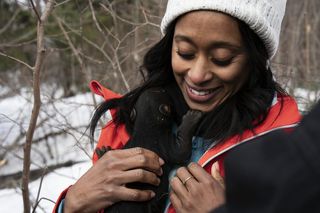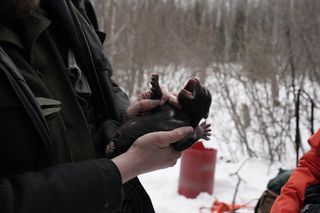Earth Day Interview: Dr. Rae Wynn-Grant loves baby bears!
Some people willingly walk into bear caves on purpose, and I needed to know why

National Geographic Explore and large carnivore wildlife ecologist Dr. Rae Wynn-Grant walks into Grizzly Bear caves to play with cubs. She's obviously doing a lot more than playing, her background in conservation biology allows this experience to teach everyone a lot about the ecosystem these amazing animals live in. You can catch her doing this on camera during National Geographic's Earth Day special Born Wild: The Next Generation , but if you want to learn more about why this work is so important, read on for my full interview.

Born Wild
Check out Dr. Rae Wynn-Grant ... and the bears
Earth Day is today, April 22. And tonight at 8 p.m. Eastern on Nat Geo you can watch Dr. Rae Wynn-Grant and a whole bunch of bears on Nat Geo.
How does someone become a National Geographic Explorer?
Oh, it's easy! No, haha, I probably shouldn't say that.
A National Geographic Explorer is, for the most part, a person who has a grant from National Geographic Society. NGS is the nonprofit arm of National Geographic. It gives grants to scientists and people who want to do some type of exploration — interesting stuff like that. It has an application process: You go to the website and describe the idea you have, fill out a whole application and put some references down. There are a couple of rounds of filtering through people, and if you make it through you get a grant.
Every grantee is named a National Geographic Explorer, and you get that title for life. It's pretty cool.

So your grant was for exploring bear cubs in Idaho?
My grant, which is ongoing, is studying Grizzly Bears. I'm doing a whole big Grizzly Bear study, but my expertise is in the movement and behavior of large carnivores, including Black Bears.
Get the What to Watch Newsletter
The latest updates, reviews and unmissable series to watch and more!
For the show Born Wild , I'm going to be going into a bear den. We're going to be on the US/Canada border in Northern Minnesota, and I'll be taking little bears out of their den for a couple of minutes to check on their health and showing the audience, then putting them right back in.
What does your support structure and safety process for this endeavor look like?
There's a lot of steps. The very first thing we have to do is know where the bear is. That means we're only going into bear dens with bears that have a GPS collar on them. It's obviously not super safe to wander around the woods looking for a bear den. So we go to known bears that have a collar on them, we know exactly where they are within a couple of square feet, and then we go in tranquilizer gun first.
We always need to tranquilize the mother for our protection, but also to keep her from getting too stressed out. A momma bear is not going to let anyone pluck her babies up even for a second and then put them back in. Because she's in a hibernation state she's not super alert, so we have a little bit more time to tranquilize her before she fully comes to. That way, when the tranquilizer drugs wear off, she's still in that sleepy hibernation state and that keeps everyone really safe.

What is the most important thing that you learn from this exploration?
It's kind of the most basic piece of information, but it's the most important — and that's the number of cubs. So we're going in about 8 weeks after they've been born, so they're teeny tiny, itty bitty, and super cute.
Say the mother has three of them. That number is so important. When I look for her again in the summer, I want to see three. And when I look for her again next winter when they're hibernating, I want to see three. If there's any fewer, that actually means there's probably something going on in the ecosystem that's not properly supporting the animals.
So it's more likely for the 'probably' to be environmental, like a food shortage?
Yes. The mother is going to be nursing her cubs for a while. It could also be some kind of human disturbance. Cubs are really susceptible to getting hit by cars. The momma bear can make it across the road really quickly, but cubs are often slower and more curious.
But usually, more often than not, I find the same number of cubs. That means the ecosystem is healthy, there aren't a lot of threats. It means whatever we're doing to protect that forest we're doing right and we need to do it in more places.
If you run into the worst-case scenario and there aren't the same number of cubs, what is the next step?
It's data. That's one of the things about being a scientist, it's not always applied action. It's data, and my next step is to figure out what killed this animal. Was it the runt of the litter? Did it get hit by a car? Is there not enough food resources? Those all lead to different actions that need to be taken.
Are the cubs aware of the camera? Do they try to interact with it?
No, they don't know about the camera. You know what's great about studying bears? They're so much like people. An eight week old cub is not so different from and eight week old baby, so a camera being present is certainly not part of its natural habitat but they don't get distracted by that.
Really, they just try to nurse. You pick them up and suddenly they're digging through your jacket trying to nurse which I think is adorable. It's hilarious, especially if they're hanging on to a Male colleague of mine.
Compared to other babies, how cute are these cubs?
The cutest. The cutest. I think primates are strong contenders here because they're so much like people, but baby bears... I mean, just wait until you see the show. I'm promising you.
The cool thing is bears and dogs have a common ancestor, way back prehistoric, so baby bears are a lot like puppies. There's pretty much nothing cuter than a little tiny puppy, so just wait.
Born Wild: The Next Generation will be simulcast on National Geographic at 8 p.m. Eastern today for Earth Day.
